Porcelain Insulator News
by Jack H. Tod
Reprinted from "INSULATORS - Crown Jewels of the Wire", July 1972, page 20
New markings seem to be the order of the day, and we have
some unexpected ones turning up and have attributed a few
of the ones reported previously. Some interesting new pin
type shapes have also turned up, and there may be nearly
100 new ones by the time the supplement to the Universal
Style Chart comes out this fall.
In February, Dennis Emery (Utah) reported having an old
cable type with the NEW LEXINGTON, 0. marking shown below.
NEW LEXINGTON, 0.
We tentatively attributed this incuse logostamp to the New
Lexington High Voltage Insulator Co, and when I visited
the site of this old Ohio plant in April, some tenacious
searching through the weeds and mud bore fruit. I located
a broken piece of the top section of what must have been a
huge multi, and it sported this identical marking.
While scratching around at this site, I also found a piece
of the top of another smaller multi with the familiar
Johns Manville marking shown below. This really doesn't
prove anything, but it may indicate New Lexington was one
of several companies who made insulators for J-M.
JOHNS-MANVILLE
Another interesting item found was a shard from the skirt
of a multi with the incuse stamp "PATENTED / June 17,
1890". Since this is the Oakman patent for the Roman
helmet type of tie, I fail to see the connection with this
multipart item, and we have no record of New Lexington
having made any Roman helmet shapes in the first place.
Bill Kuhar (Bethlehem, Pa.) has also come up with a gem of
a find. This is a very unusual shape of a wet process pin
type with the large incuse LIMA NY marking shown below,
LIMA NY
and we tentatively attribute this to Lima Insulator Co.,
Lima, N.Y. (Fred M. Locke, 1904-1908). This has to be
rated as a goody item because of its unusual shape and the
scarcity of the marking - first I've heard of.
The markings shown below are definitely attributed to
Franklin Porcelain Co., Norristown, Pa. (estimated 1920-1928). They are all incuse stamps on various pin types.
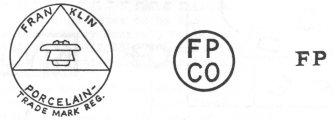
The monogram type was reported by Robert Winkler and Paul
Mohrs (Indiana), the circle-F P CO by Bill Kuhar and Ken
Schumacher (Urbana, Ill.), and the small FP by these
fellows and several others.
I also spent a couple of days at the old Findlay
Electrical Porcelain Co. dump, and all of the incuse markings below are now confirmed as being from that
plant and used on wet process pin types. We continue to
refer to these insulators as "Findlays", and it is a
moot point whether to call these F.E.P. markings if the
items were made before 1927 or Porcelain Products Inc.
markings if they were made after the 1927 merger date. Note also that we previously had no record of this
Findlay, Ohio plant having made wet process pin types,
and finding pieces of these there came as quite a
surprise to me.

Bob Stewart (Cincinnati) has come up with another find
of the year -- the embossed F E D C 0 marking shown
below. This is on the crown of a dry process U-47 pony,
brown glaze. This is not only the first report of this
name, but it confirms yet another company as having made
pin types. This was the trade mark of the old Federal
Porcelain Co., Carey, Ohio (1917 - 1927) - the plant now owned by the Clarken Co.
and operated as Porcelain Products Company.

Ken Schumacher (Urbana, Ill.) also reports that Ohio Brass is now adopting their
new logo marking as shown above, but on new styles only. More information
later on whether this is a recess-embossed marking like the other O-B markings
have been for so many years. Ken specializes in O-B and Illinois insulators and is
very knowledgeable on these items.
While visiting the Knox Porcelain Co. plant recently, I discovered that pin types
are now being marked there with the under-glaze marking shown above. This is
the same "hobo type" as was the previous incuse marking, and it was indicated
that the new marking type was introduced about two years ago.
For some time we have been curious as to the origin of the "HP' marking on
certain dry press pin types (See Gerald Brown's book, page 111). Since these
insulators emanate from Canada, I suspicioned it might be Hamilton Porcelain, and
a couple of letters up that way confirmed this as shown by the logo in their
letterhead below.

Ron LaSalle (Rome, N.Y.) has not only turned up a couple of light blue-gray U-395 Mickey Mouses (mice) but also reports a marking on one of JUNE 17, 1913
and on the other one the last 2 or 3 letters of the word CABLE. This date
naturally fits the 1908-1920 period for Pittsburgh High Voltage Insulator Co. who
made the U-395 items. This company in Derry, Pa. was the forerunner of
Westinghouse.
We now have definite information about the insulator
shown on page 21 (April) and owned by Jeff Osler (South
Bend, Ind.). I found this in the patent gazettes to be
the invention of Henry Prenzel, Phila, Pa., patent No.
315,660 of April 14, 1885, Supporting-Insulator for
Telegraph Wires.
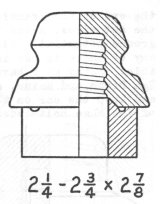
The idea was that the wire (in appropriate groove size)
could first be strung and then all the tops of the
insulators screwed down to hold the wire in place at
each pole. This just has to outclass the Harloe and
Ranson designs for the most impractical insulator design
since slight movement or vibration of the conductor
would quickly loosen the top cap and allow the conductor
to fall out. Manufacturer of this item is unknown, but I
would estimate manufacture during the 1900-1910 period.
Jeff and his dad got this item for $4 in an antique
shop, so we just have to give them the blue ribbon for
buy of the year. This insulator is naturally a classic
and as far as we know to date is unique.
Well, I'll have to admit that I have come onto at least
one unusual thing lately. I and other collectors in the
midwest area have this peculiar pin type shown at right.
Will one of you fellows back there who has been finding
these things please let us know how they are used. To
say the least, we are just slightly curious!
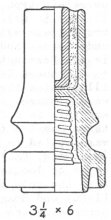
The piece in the top of it is a copper
socket or bushing held in place by sulphur
on some and by some other compound in
others. The threaded thimble is cemented
in as is customary, but it is unusual
because of its 1" thread size. I haven't
ever seen a zinc thimble other than 1-3/8".
In answer to the people who have asked about them, the
unusual insulators pictured below are "bolt-end"
insulators. They have 3/4" machine threads in brash
bushings and held in place with a lead alloy. The idea
of these is to remind (or prevent) the lineman to keep
his tootsies off
the end of the transformer can bolts while he's working
on the hot wires, since the case and thus the bolts are at
ground potential. Clever idea maybe, but I've never seen
any of these in use in my travels, and that is considerable. Seems as I have looked at every power pole
between San Diego and Maine, and it's quite a trick to do
that and keep the car on the freeway at 60 mph. I
received one of the Whse bolt-enders from Bob Gilbert
(Ky.) on a trade.
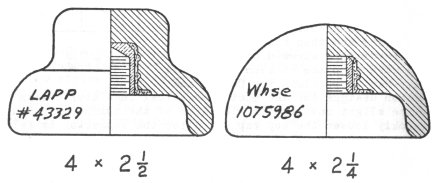
Forrest Jones (New Carlisle, 0.) is the latest one to
turn up a new threadless porcelain type as shown here
(also page 13, May issue). This specimen has a rich brown
glaze with light cream streaks and undertones, and the
consensus is that it is of "Bennington Ware" (Vermont).
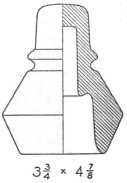
Frances Terrill (Old Bottle Magazine) illustrates three
threadless types which were pictured in the 1859 Elliot
document, and this is definitely the second of these
located to date. The first shape was located or reported
by, Bill Cosner (New Hope, Pa.) some time ago. We are now
eager to locate the other one, of course. Aside from
these two, the only, other threadless reported have been
LaSalle's (left) and Sprague's (right below). All these
threadless porcelains are exceedingly rare or unique.
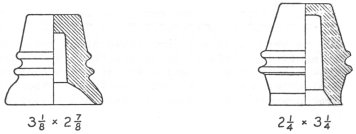
Steve Freedman (Wallingford,
Conn.) reported the insulator at right and asked what it
was used for. Here again, we easily found the patent in
the gazette but had to await receipt of the full patent to
find out what is was used for.
This specimen is marked in equal quadrants at the top of the flutes " M & H /
PATENT / MAY 18 / 1915 " This is patent 1,140,050, inventors
Robert A. Manwaring & James T. Hessel, New Haven, Conn.
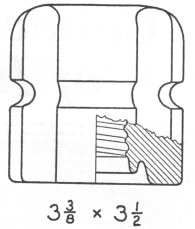
The insulators were to be mounted on street light poles
with the ordinary side bracket pins, and they supported
the vertical feed wire from the main overhead conductor
downward to the region of the light fixture mast arm. Once more, another goody pin type. I have word that this
specimen is sky-blue glaze. Congrats, Steve.
We have always known the exact location (address) of the
very old Pass & Seymour plant near Syracuse, N.Y. where
the very first wet process pin types were made, and we
have been anxious to survey this site for the past year
or so. Lew Hohn (Rochester, N.Y.) has made a couple of
excursions there recently and writes a very interesting
and detailed letter about coping with the frustrations
of being rained out once and then later trying to turn
up evidence which would confirm a number of pin types we
believe to be from this P & S plant.
If you think looking for insulator shards among the
weeds and briar patches of Ohio is rough, ask Lew about
how he had to do it in the center of a used car lot (lot
now owned by city) and in an area of an all-paved
service station. Well, after a number of 3' x 3' x 3'
holes in an unoccupied section of the area, lots of
pieces of tin, can&, boxes, ashes, few bottles, etc. -
but no insulator shards. Lew promises to keep trying
though. Good work, Lew. We're all behind you, and "rots
of ruck".
Dora assures me that all you insulator buffs can put up with this fuzzy
typewriter which allows copy to be sent to photo-ready. The intent is to speed
up the issues to regain lost time, and we've found nobody opposed to that.
|
